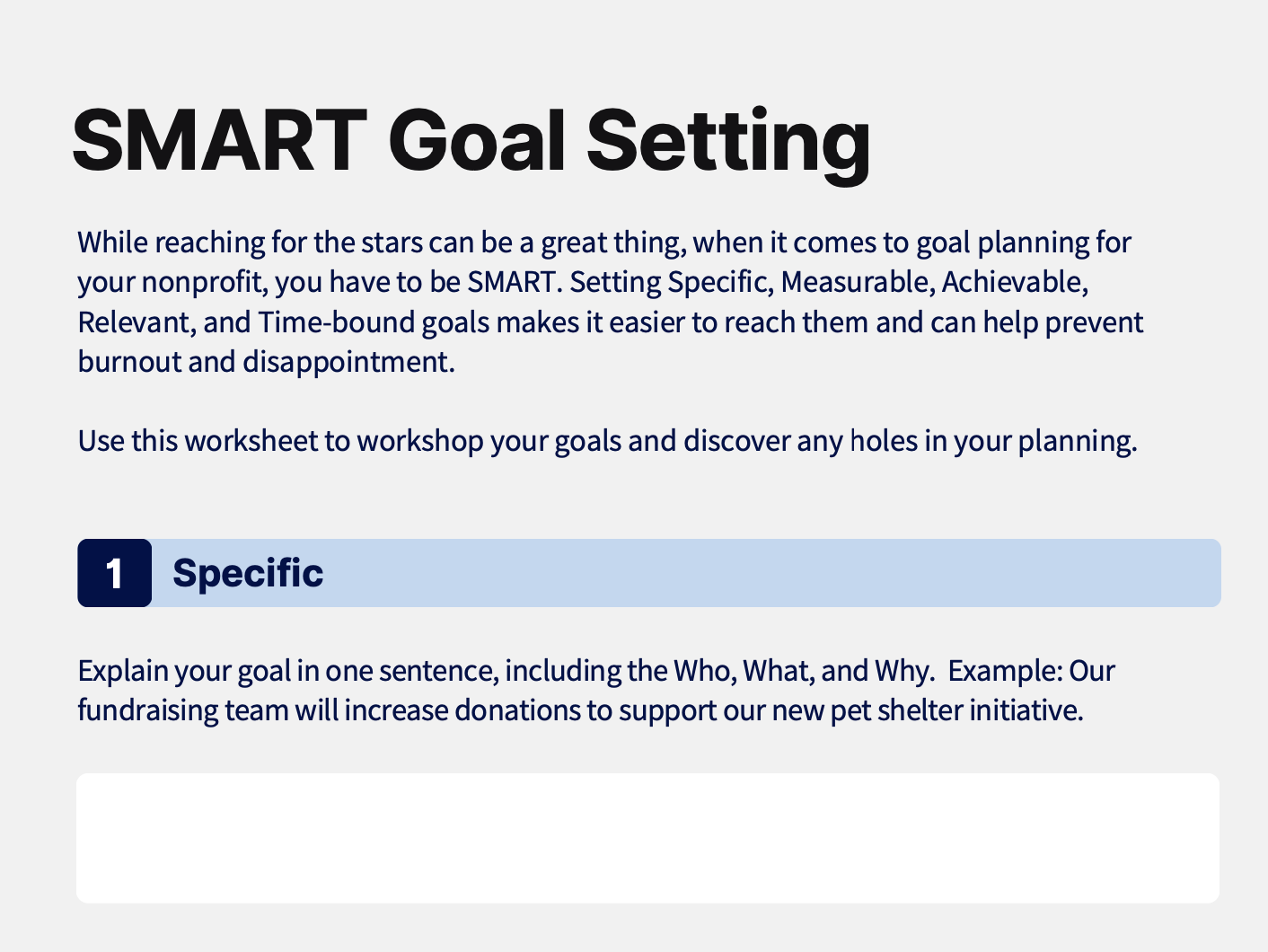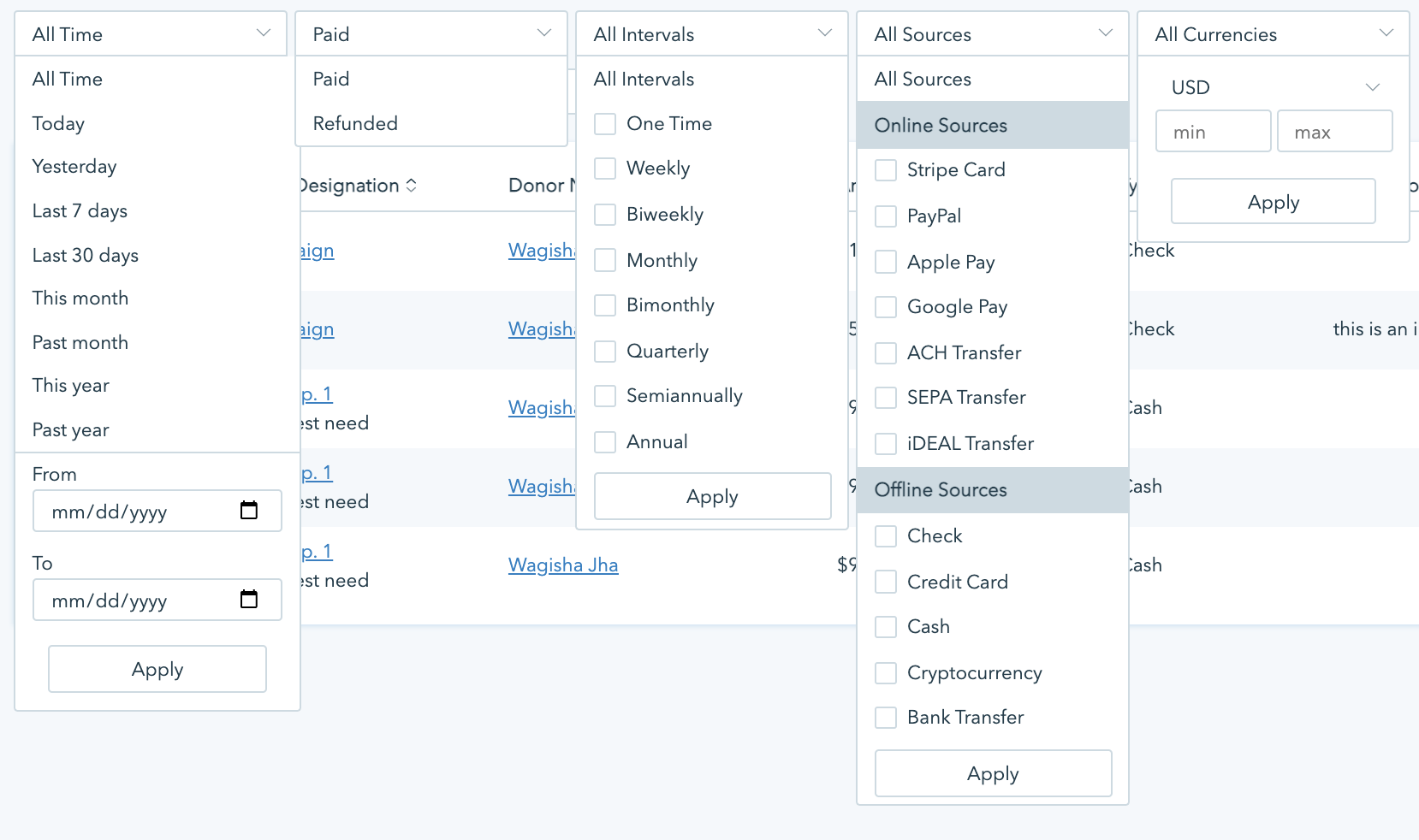Nonprofits depend on fundraising to deliver their missions and keep their doors open. This means that setting and meeting fundraising goals are frequently on top of nonprofit professionals’ minds.
Due to this, there is a sea of information out there about fundraising, and this makes it understandably difficult to know what to do.
Whether your nonprofit organization is setting annual goals or short-term campaign goals – setting and meeting fundraising goals can be complex.
In this article, we’ll teach you a SMART way to set fundraising goals that you can actually attain. Read on!
How to Set Fundraising Goals
There are many ways out there in which you can go about setting your fundraising goals. In this article, we are focusing on one of the most common and most effective methods out there: the SMART method for goal-setting.
The SMART Method for Setting Fundraising Goals and Objectives
One of the most popular goal-setting frameworks is the SMART system. In 1981, George Duran outlined a helpful objective-setting system in his article, “There’s a S.M.A.R.T. Way to Write Management’s Goals and Objectives.” Since 1981, variations of the SMART model have made their way into organizations, businesses, schools, and even into the personal development arena.
SMART is an acronym for:
Specific – The goal should deal with a specific area of performance or a specific KPI.
Measurable – The goal should be measurable, not subjective.
Attainable – The goal should be ambitious, but remaining within the realm of possibility.
Relevant – The goal should be connected to the overall mission and vision of the organization.
Time-Based – The goal should have a deadline.
Want more hands-on guidance? Download our free SMART goal setting worksheet!

So, how can your nonprofit use the SMART framework of goal-setting to set fundraising goals? Let’s find out!
Specific
When setting your fundraising goal(s), first clarify the overall context. What are you hoping to achieve with your fundraising? What is your overall goal?
Then, clarify who will benefit from this fundraising initiative.
Finally, outline how much you need to fundraise or how many donors you need to acquire to accomplish that.
Unlike measuring the social impact of a whole organization, it’s much easier to quantify fundraising goals. Simply try to stay away from generic statements such as “We want to do better than last year.”
Here are examples of specific fundraising goals:
- Fundraise $50,000 to support 500 women who are victims of domestic violence
- Fundraise $10,000 to support the renovation of the animal shelter
- Gain 100 new donors
- Raise 25% more in donations compared to last quarter
Measurable
Without being able to measure progress, you won’t know if you’ve met your fundraising goals! Not setting measurable goals can also cause everyone to be on a completely different page.
An organization should be able to track progress and measure success.
To set measurable fundraising goals, make sure you know:
- what will be measured
- who will measure it
- how they will measure it
Setting measurable fundraising goals boasts many benefits. It motivates your staff, enhances clarity, inspires donors to give, and paints a clearer picture of your progress. This is incredibly helpful for organizations of all sizes.
Attainable
As a nonprofit, you should strive to set goals that stretch you and are ambitious enough to challenge you. However, those goals should not be unrealistic and unattainable.
It’s quite easy to get carried away and set goals that ultimately can’t and won’t be met. Goals that are too easy to achieve aren’t satisfying or motivating, but goals that are too difficult to achieve can make people feel inadequate. It’s important to find a goal somewhere in the middle.
To understand what’s achievable and feasible for your nonprofit, consider:
- the success of your previous fundraising campaigns
- the average number of donors
- the average donation size
- the time you have for the campaign
- other resources you are able to commit (e.g. employees, volunteers)
You can pull your donor and donation information right from your Donorbox account! Simply sort your donor data by filters like campaign, number of donations, donation amount, and more. Learn more about our donor management features here.

Plus, use Donorbox’s reporting templates to quickly pull more detailed data! Run a donor overview, new donor, or LYBUNT (last year but not this year) report. This info will help you ensure any fundraising goals you set are fully attainable!
Relevant
Before you invest any resources in achieving a fundraising goal, it’s crucial to triple-check if your goals are relevant to your nonprofit’s mission and vision.
Ask yourself:
- Does this fundraising goal contribute to my mission and vision?
- Is this going to significantly impact my intended beneficiaries?
- Does the fundraising goal relate to my yearly strategy?
- What is the return on investment in terms of impact?
Get very clear on the relevance before starting any activities. This also helps you establish the “why” – and when there’s a “why,” everything will flow more smoothly.
Time-Based
Every successful fundraising campaign should have a beginning and an end. Projects and campaigns that stretch out can become burdensome and unmotivating for both staff and volunteers. If a goal isn’t time-based, you can put it off indefinitely.
Having a timeline also helps with tracking progress. For example, you could be one month into a two-month campaign, but you only raised 15% of the planned amount. This informs your decision-making. You are now able to re-plan and think of ways you can increase your efforts and meet the end goal in time.
Examples of Smart Goals for Nonprofits
Now, let’s look at an example of a SMART goal:
“The giving season campaign will begin on December 1st and run through December 31st. The goal is to raise $25,000 in order to help 500 girls develop professional skills they can use later in life.
Last year’s campaign raised $20,000. Reaching the $25,000 goal will allow our nonprofit to help many more girls. The launch of our recurring donations program will help us with the raising the additional $5,000.”
Specific – The goal is to raise $25,000.
Measurable – The goal is quantifiable and measurable (dollars raised).
Ambitious/Attainable – It’s more than last year, but not overly ambitious – especially with the new recurring donations program.
Relevant – The goal will help the nonprofit’s main beneficiaries.
Time-Based – The campaign begins on December 1st and ends on December 31st.
How to Achieve Fundraising Goals in 13 Steps
To make sure you’re staying on the right path and steadily moving towards accomplishing your mission, we’ve compiled a couple of best practices to achieve your SMART goals.
1. Don’t Lose Sight Of The Bigger Picture
Losing sight of the bigger picture happens to everyone, especially nonprofit professionals. With all the KPIs, fundraising, managing volunteers, budgets – it’s easy to get caught up in the day-to-day.
As you’re going about meeting your fundraising goals, take time to remind yourself why you’re doing what you’re doing, what ‘bigger thing’ you are contributing to. This will make it more motivating to go through the motions of day-to-day nonprofit life.
2. Don’t Get Blinded by The Bigger Picture
On the opposite end of the spectrum, some nonprofit professionals – usually out of a passion for their cause – get so focused on the mission that they don’t take time to work on smaller activities.
Focusing on smaller activities and incrementally moving towards the mission or vision is very important for making a dent in the overall goal.
3. Collect Relevant Data
The best way to set ambitious and attainable fundraising goals – and meet them – is to start thinking about them way in advance. When you’re planning a fundraising campaign, decide what kind of data and KPIs will help inform future campaigns.
Collect that information throughout the campaign.
- Which channels attracted the most donors?
- Which channels had the highest ROIs?
- How many donors were new supporters versus returning supporters? Where did the new ones come from, and how can you maximize that reach?
It’s important to take time to reflect on the past so that you can avoid your mistakes and repeat what worked well.
4. Break Down Your Goals
To reach a big goal (or a mission), you need to break it down into smaller goals and then tackle each one with a plan. It is true that working on smaller objectives can sometimes make employees unmotivated, but that is only IF they lose sight of the big picture – see Step 1.
However, working on achieving smaller objectives allows you to make progress and see progress faster and doesn’t make you as overwhelmed.
5. Create a Solid Plan
You can set outstanding SMART goals, but they won’t get you anywhere unless you have a plan for how to reach them.
Create plans that will help you achieve your goals. Make sure they include a timeline with responsibilities and deadlines, as well as key tactics and activities that will help you meet them.
6. Stay Accountable
After you’ve set SMART goals, broken them down, and created plans for how to achieve them, it’s very important to stay accountable.
If you’ve already decided on a way to measure your goals, staying accountable is going to be much easier. Having “check-in” points when you take a look at your progress together with your team will be invaluable when it comes to staying accountable.
Work on an accountability mindset with your team by making sure everyone feels a sense of shared responsibility toward meeting your nonprofit’s fundraising goals.
Pro tip: Use our free SWOT Analysis Worksheet to evaluate your strengths, weaknesses, opportunities, and threats. This will help you remain accountable as you work toward your ultimate fundraising goal!
7. Consider Using Fundraising Meters
A fundraising meter measures progress toward a fundraising goal.
Your fundraisers (especially your board and staff) will be more motivated to fundraise thanks to a visible tracker of progress, and your donors will be able to see the impact of their donations.
Check out how Tapestry used a goal meter on their Donorbox crowdfunding page to encourage more giving. They surpassed their goal by more than $4,000!

Get Started With Donorbox
Goals are more likely to be achieved if donors can clearly see the fundraising progress and they can easily visualize their impact.
8. Celebrate Successes
Nonprofit professionals are some of the most giving and dedicated professionals out there. Many enter the nonprofit arena with pure and good intentions – to help others (be it animals, nature, women, the homeless, or something else).
The reality of working in the sector can be hard. The budgets are strained, the hours can be long, there are a lot of beneficiaries to serve, and the organizations are often held to impossible standards. This is why it’s incredibly important to celebrate successes.
When you reach a milestone, thank everyone who contributed and yourself! Reward the highest performers. This will go a long way!
9. Ask Your Donors For Inputs
Your donors and supporters have a lot of great ideas. All you need to do is listen!
When you’re brainstorming for the upcoming year/project/fundraising campaign, don’t hesitate to ask for their input.
You can create a simple online survey using SurveyMonkey or Google Forms and send it out to your email database (as well as post it on your social media). Your question will depend on what you hope to learn, but generally, donor surveys help inform your fundraising efforts and strategies.
Pro tip: Recording donor communication is a great way to build meaningful relationships with your donors – without reaching out too much. You can record a donor’s survey responses using Donorbox’s donor management tools. Simply select whether the communication was inbound or outbound and choose the channel. Here’s how it looks:

10. Be Open and Transparent
Goals can’t be reached if no one knows about them. To ensure that you reach your goals, be very transparent about them.
Announce them to the entire organization (if they pertain to the entire organization), from managing directors to interns. This has many benefits. You’ll be creating a culture of transparency in your organization, you will be motivating the staff, as well as donors.
Knowing the “big picture” is highly motivating for both big and small donors and lets every donor know they are helping you reach your goals.
11. Keep Your Resources in Mind
Resources are the means at your disposal that make fundraising goals achievable. They should be considered as you plan how to use them to complement your fundraising efforts.
Create a detailed outlook of the costs associated with your campaign: financial, allocated staff time, advertising/promotion costs, vendor contracts, startup costs, and anything else relevant to your goal. Leave room in your budget for innovation and agility in the face of the unforeseen. Think about staff members and their skills. Consider any major donors and supporters that you can count on.
This also includes sizing up your network as a whole. Have you considered asking your top supporters to fundraise on your behalf?
Donorbox Peer-to-Peer fundraising makes it easy for your organization to reach its goal. Simply create a main campaign and either invite your top supporters from your Donorbox account or allow anyone to sign up to fundraise on our behalf straight from your campaign. From there, they’ll receive an email with instructions to set up their fundraising pages. Any donations they collect will automatically flow to your Donorbox account.
Check out how this organization used peer-to-peer. They allowed anyone to sign up to fundraise on their behalf.

Launch Your Peer-to-Peer Campaign
12. Make The Donation Process Easy and Smooth
Today’s online donors expect an easy and smooth donation process. This is why choosing a powerful and effective donation software for your nonprofit is essential.
A donation software takes care of the entire process for you: the donation form, collecting donor information, processing the donation, and making sure it reaches your nonprofit’s bank account.
Donorbox offers state-of-the-art fundraising tools to help you smash your fundraising goals. With multi-step, customizable donation forms, text-to-give, crowdfunding and peer-to-peer, and in-person giving with the Donorbox Live™ Kiosk app, Donorbox can help organizations of all sizes scale their fundraising. Learn more about all of our features here.
13. Use Social Media
It’s no longer a matter of discussion whether your nonprofit organization should be active on social media networks – because you should.
Social media platforms have now been adopted on a large enough scale and for a long enough time. And nonprofits are really starting to understand how social media can support their strategies. This includes understanding and implementing things like Instagram Stories, influencer marketing, or live streaming.
Conclusion
Reaching your fundraising goals is hard work, but you can do it!
Take the time to clearly define your fundraising goals, openly communicate them both inside your organization and outwardly to donors, track your progress, celebrate your victories, and stay positive and resilient. Use our resources to help you along the way!
Make sure you check out our Nonprofit Blog for more tips on how to meet your nonprofit fundraising goals. Subscribe to our newsletter for a monthly delivery of our best resources straight to your inbox.









